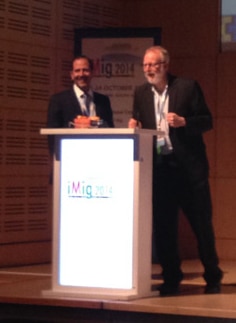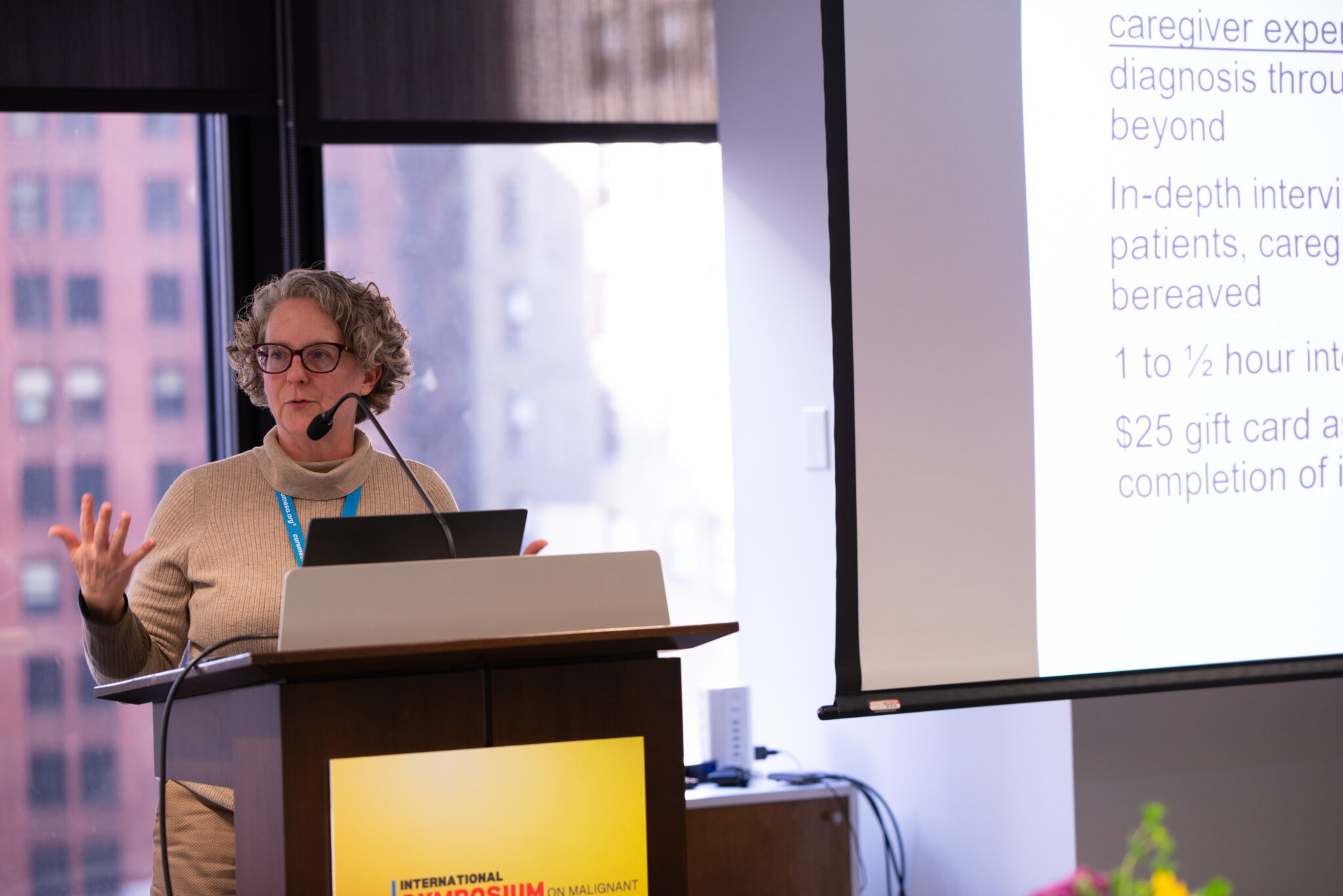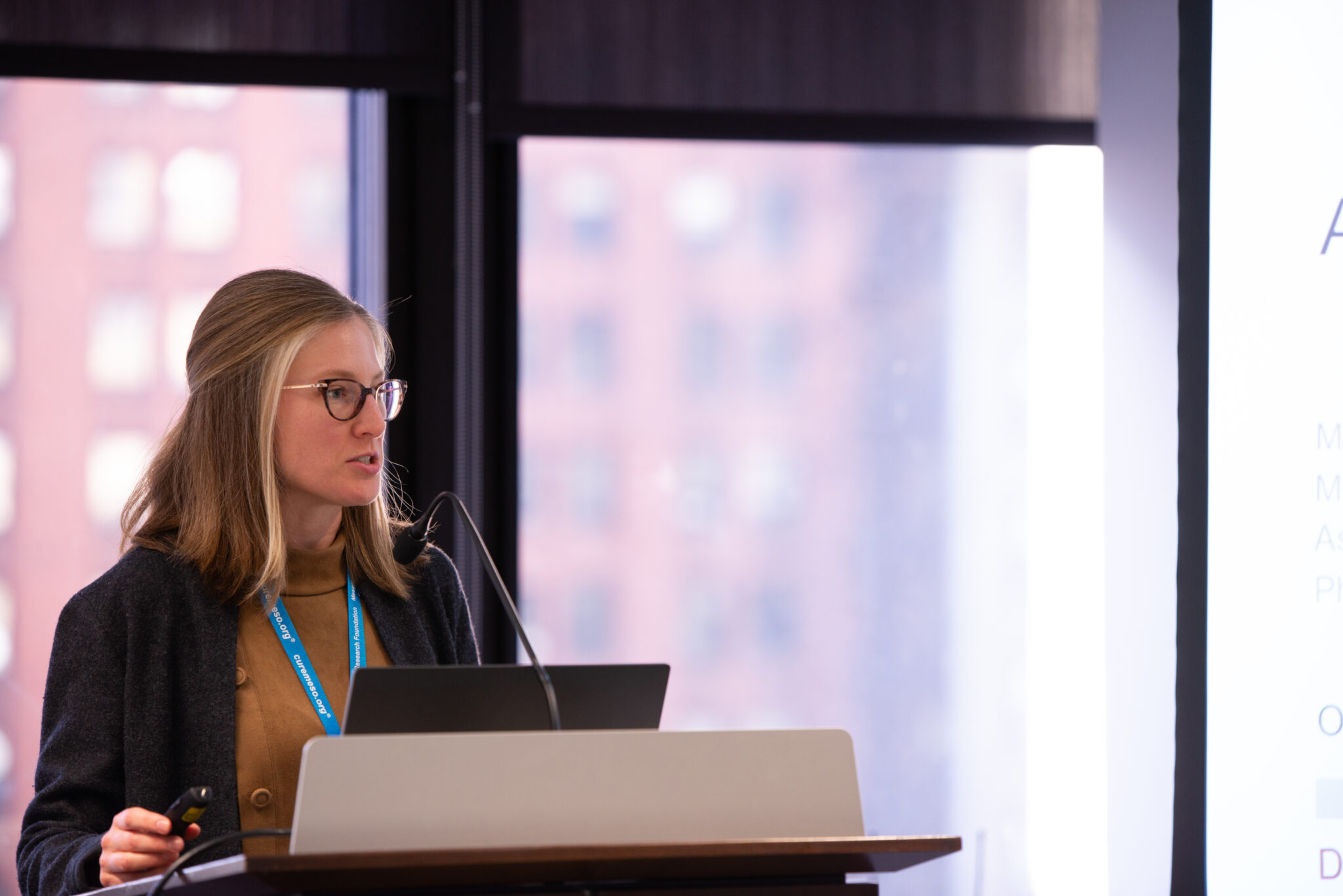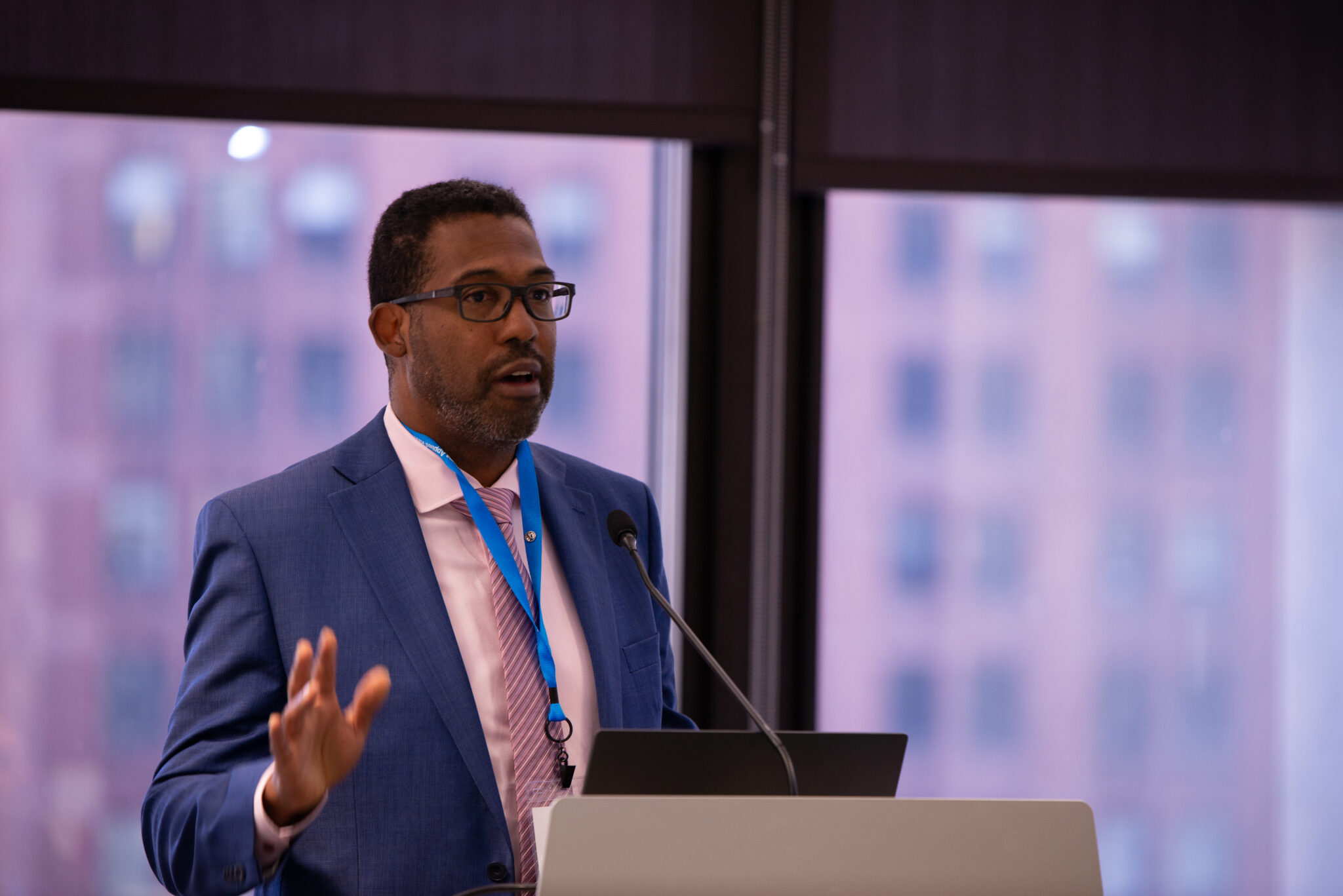 ***The Best of iMig 2014 updates were created by iMig and distributed to conference attendees during iMig 2014. The following is a verbatim re-post of those updates.***
***The Best of iMig 2014 updates were created by iMig and distributed to conference attendees during iMig 2014. The following is a verbatim re-post of those updates.***
2014 Wagner Medalist Announced
Dr. Raffit Hassan discusses immunologic interventions in mesothelioma
Click here to watch Dr. Raffit Hassan
The 2014 winner of the Wagner Medal was Raffit Hassan. Dr. Hassan was trained in Kashmir and the United States and is currently Head, Thoracic and Solid Tumor Immunotherapy Section, Center for Cancer Research at the National Cancer Institute. Dr. Hassan has played pivotal role in validating the tumor differentiation antigen mesothelin as a target for cancer therapy and development of mesothelin targeted immunotherapy. This work has laid the foundation for several mesothelin directed agents that he is evaluating in the clinic for treatment of mesothelioma, lung and pancreatic cancer. Dr. Hassan has published extensively in pleural mesothelioma and was recently given the Pioneer Award by the Mesothelioma Foundation. His award lecture was focused on mesothelin-targeted therapies for the treatment of mesothelioma.
Asbestos Exposure – A Long and Troubling History
Asbestos Blues: A History of Asbestos Mining in South Africa – Jock McCulloch
Australia and South Africa are the only countries to have mined crocidolite or blue asbestos. Crocidolite was mined in the Northern Cape for one hundred years and at Wittenoom in Western Australia from 1944 until 1966. Mining has left a pandemic of asbestos disease in the Northern Cape and although production levels were modest, Wittenoom has become the site of Australia’s worst occupational health disaster. The mines of the Northern Cape also supplied the first conclusive evidence linking asbestos to mesothelioma, but discovery had no impact on the global consumption of asbestos.
Corruption is a serious problem in communities burdened by asbestos-related disease and this has justifiably bred profound mistrust of outsiders involved in asbestos compensation, research, or litigation. This corruption has involved both suppression and destruction of knowledge and this has been one of the most effective strategies employed by the asbestos industry. The history of suppression of information documenting the dangers of asbestos exposure dates back to the 1930’s when the work of George Slade demonstrating the health effects of asbestos exposure in miners was suppressed and ultimately destroyed. These actions contributed to the absence of any regulation at all of asbestos mining in South Africa until 1955. In the United States, the asbestos industry actually paid researchers to claim that asbestos was not significantly associated with mesothelioma. Corruption of science slows regulatory legislation and limits the success of litigation aimed at compensating victims.
Occasional Exposure to Asbestos: What is the Risk? – Sjaak Burgers
The question “What is the risk of occasional asbestos exposure?” has a scientific, a political and a social answer, which are all interrelated.
Data from populations with a low, occasional asbestos exposure is scarce. A search in Western Australia uncovered asbestos exposure, sufficient to cause mesothelioma in almost all cases. Whether the risk for mesothelioma and lung cancer increases linearly or has a particular threshold is still not completely clear, but the weight of evidence supports the view that even occasional asbestos exposure is related to increased risk for mesothelioma and lung cancer. Observations supporting the view that even minimal asbestos exposure carries significant risk have provided the basis for political discussions on reimbursement for asbestos victims. These data have been used by the World Health Organization and national policy makers to set the Maximal Tolerated Risk and the Negligible Risk Level for asbestos exposure in the working environment and at home.
In the Netherlands, the same risk estimates are part of the guideline “Occasional Asbestos Exposure”. This guideline covers the laws and regulations on asbestos, and focuses on reliable quantification of the exposition, and uses the risk estimates to educate the victims about the health risks. It has proven to be helpful to ease the panic that usually accompanies the discovery of asbestos in the neighborhood.
New Molecules and New Therapies – Advancing Mesothelioma Care
Keynote, Dean Fennell presents on treatment developments for mesothelioma
Click here to watch Dean Fennell
Paul Bass summarizes evidence from studies showing specific targeting of cancer stem called by defactinib, a novel inhibitor of FAK
Click here to watch Paul Baas
Role of Focal Adhesion Kinase (FAK) Inhibition in Mesothelioma – Ravi Salfia
Focal adhesion kinase (FAK) is a non-receptor tyrosine kinase that plays an important role in signal transduction pathways that are initiated at sites of integrin-mediated cell adhesions and by growth factor receptors. It is a key regulator of survival, proliferation, migration and invasion, all of which are all involved in the development and progression of cancer. FAK has also been implicated in the phosphorylation of several focal adhesion associated proteins, including paxillin. Overexpression and/or increased activity of FAK is common in a wide variety of human cancers and a large and growing body of literature has provided strong evidence that FAK has important roles in tumor formation and metastasis.
Inhibition or modulation of FAK would appear to be a potential way to treat multiple cancers, including mesothelioma. However, since FAK is a strong mediator of survival signaling, tumor cells with high levels of FAK could be more resistant against classic anti-cancer therapy. There are now multiple agents that specifically target FAK and inhibit this kinase. Studies of FAK inhibitors in vitro and in animal models of different cancers have shown that these agents effectively decrease tumor growth, decrease invasion and metastasis, and inhibit pancreatic tumor microenvironment components, such as tumor associated fibroblasts and macrophages. FAK inhibition also promotes apoptosis and modulates the activity of nuclear factor E2-related factor 2 (Nrf2). The effects of FAK inhibition on Nrf2 activity may be particularly important since the Nrf2 signal pathway may function to protect cancer cells from against drug-induced cell death. Clinical trials with FAK inhibitors in patients with mesothelioma are now in progress.
Raphael Bueno presents the design of the phase II study of the new FAK inhibitor, defactinib for the treatment of patients with mesothelioma
Click here to watch Raphael Bueno
Establishing Tissue Banks to Support Mesothelioma Research
MESOBANK: A Clinicobiological Database for Epidemiological and Translational Research for Mesothelioma – Françoise Galateau-Sallé
The French Ministry of Health and the National Cancer Institute have funded the Clinico-biological database for epidemiological and translational research since 2011. The goal of this project was to collect structured data on follow-up and outcomes in order to structure a collection of samples of high quality for use in basic and translational research, to develop inter-institutional systems and to establish quality management policies.
The collaborative effort of the French Multicentic National Register network MESONAT and of the Center of Excellence MESOPATH made it possible to extend these efforts to mesothelioma by the creation of MESOBANK, a virtual and exhaustive repository of national data and samples pertaining to mesothelioma. The MESOBANK database was interconnected with that of the National Referent Center on pleural malignant mesothelioma and rare peritoneal tumors, supported by the French National Cancer Institute and is was also was closely networked with the National Program for Monitoring of Mesothelioma, the French MESONAT network and with the International Excellence Center.
The MESOBANK has gathered 7,725 mesothelioma samples (with >10,000 paraffin embedded blocks and 1,489 frozen tissue samples) from patients with certified diagnoses of mesothelioma. Assessment of these tissues has included systematic analysis of 10 immunohistochemical markers, and p16 deletion by FISH, allowing studies of sensitivity of markers for the diagnosis and prognosis of mesothelioma with a high statistical power. MESOBANK can provide support for new basic genomic and pharmacogenomic research programs to foster a better understanding of the molecular basis of mesothelioma and improved early detection and management of this disease.
MesobanK UK – An International Bioresource of Mesothelioma Tissue – Robert Rintoul
Availability of quality assured, fully annotated mesothelioma tissue collected to rigorous standard operating procedures (SOPs) to facilitate basic and translational research, is very limited. MesobanK in the United Kingdom (UK) was funded by the British Lung Foundation and Mick Knighton Mesothelioma Research Fund to provide researchers with access to a wide range of samples from patients with this disease.
The overall objectives of MesobanK are to:
- Construct a tissue microarray (TMA) from 1000 cases of mesothelioma linked to a clinical data set.
- Collect 300 cases of fresh mesothelioma tissue, whole blood, serum, and plasma linked to a clinical data set with follow up data from the National Cancer Registration Service.
- Develop 20 new fully annotated mesothelioma cell lines.
MesobanK abides by all relevant United Kingdom and European Union legislation regarding the collection of tissue and data. The project is overseen by a Steering Committee and an independent Scientific Advisory Board reviews applications for samples, which are prioritized for access based solely on scientific merit.
To date, 500 of the 1000 mesothelioma case designated cases for TMA have been acquired from UK pathology departments and the TMA construction is underway. Several new cell lines are also being characterized. Quality assurance and control are being undertaken to ensure suitability for research use.
MesobanK will also act as a repository for samples collected within clinical trials.
Dr. L Mutti speaks on novel strategies and critical biomarkers for mesothelioma
Click here to watch Dr. Mutti
To learn more about iMig 2014, read Best of iMig 2014: Day 1 and Best of iMig 2014: Day 3.
“Best of iMig 2014” has been supported by the unrestricted sponsorship of Versastem, Inc.
***The Best of iMig 2014 updates were created by iMig and distributed to conference attendees during iMig 2014. The following is a verbatim re-post of those updates.***





